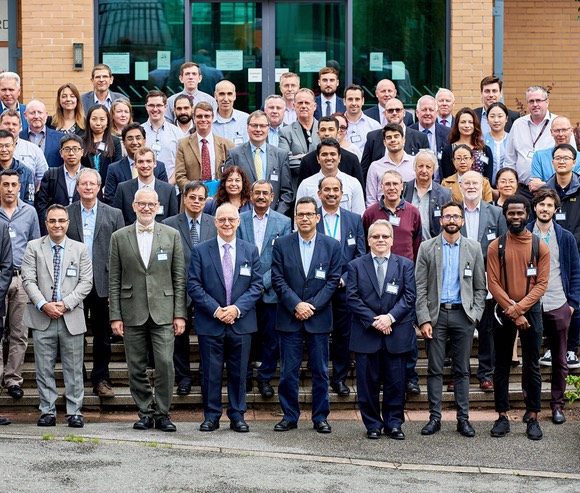On July 9-10th, Jean-Michel Romano (ESR) presented part of the results of the Laser4fun project at the Polymer Process Engineering PPE’19. The event was organised by the Polymer IRC in Bradford (UK).

On July 9-10th, Jean-Michel Romano (ESR) presented part of the results of the Laser4fun project at the Polymer Process Engineering PPE’19. The event was organised by the Polymer IRC in Bradford (UK).

Results of the work in the Laser4Fun project has been published as:
Tobias Stark , Thomas Kiedrowski, Holger Marschall and Andrés Fabián Lasagni. Avoiding Starvation in Tribocontact Through Active Lubricant Transport in Laser Textured Surfaces. Lubricants 2019, 7(6), 54.
Laser texturing is a viable tool to enhance the tribological performance of surfaces. Especially textures created with Direct Laser Interference Patterning (DLIP) show outstanding improvement in terms of reduction of coefficient of friction (COF) as well as the extension of oil film lifetime. However, since DLIP textures have a limited depth, they can be quickly damaged, especially within the tribocontact area, where wear occurs. This study aims at elucidating the fluid dynamical behavior of the lubricant in the surroundings of the tribocontact where channel-like surface textures are left after the abrasion wear inside the tribocontact area. In a first step, numerical investigations of lubricant wetting phenomena are performed applying OpenFOAM. The results show that narrow channels (width of 10 μm) allow higher spreading than wide channels (width of 30 μm). In a second step, fluid transport inside DLIP textures is investigated experimentally. The results show an anisotropic spreading with the spreading velocity dependent on the period and depth of the laser textures. A mechanism is introduced for how lubricant can be transported out of the channels into the tribocontact. The main conclusion of this study is that active lubricant transport in laser textured surfaces can avoid starvation in the tribocontact.
Results of the work in the Laser4Fun project has been published as:
Storm, S., Alamri, S., Soldera, M., Kunze, T., Lasagni, A. F., How to Tailor Structural Colors for Extended Visibility and White Light Generation Employing Direct Laser Interference Patterning. Macromol. Chem. Phys. 2019, 1900205.
The appearance of a surface can be controlled by creating periodic microstructures designed to diffract light and produce structural colors. Nevertheless, since structural coloration is based on diffraction, the produced colors have a strong dependence on the viewing angle and absence of coloration takes place while tilting the samples. In this work direct laser interference patterning is used to firstly provide transparent polymer sheets a structural coloration with a high‐range observation angle, and secondly to demonstrate the combination of structural colors, producing a white coloring effect. The employed approaches are based on the fabrication of micro‐gratings with multiple periods in the same structured area and on the engineering of the diffraction orders of the diffraction spectrum. The patterned surfaces are characterized by confocal microscopy and angular spectrometry in reflection mode. The morphological characterization shows homogeneous surface patterns, while the spectral results demonstrate that combining four spatial periods on a single patterned surface, a white appearance is obtained over an angular observation range higher than 30°. The experimental results are supported by theoretical predictions by means of generalized formulas based on the diffraction of light.
The Direct Laser Interference Patterning (DLIP) technique has been used to create a functionalized surface on stainless steel (black area). In combination with an additional post-treatment, the metal surface has extremely water-repellent properties with contact angles of over 150 degrees. The microscopic surface exhibits “miniature mountains” that create a superhydrophobic surface, similar to its natural pendent on a lotus leaf. The sample was placed under water (no wetting of the structured areas is observed) to emphasize the water repellency. Consequently, even if the surface gets wet, it actually stays dry in the laser processed areas. Finally, DLIP allows for self-cleaning properties on technological surfaces at industrially-relevant throughput.
Results of the work in the Laser4Fun project has been published as:
Vittorio Vercillo, José Tiago Cardoso, Daniel Huerta-Murillo, Simone Tonnicchia, Alexandre Laroche, Javier Alejandro Mayén Guillén, José Luis Ocaña, Andrés Fabián Lasagni, Elmar Bonaccurso. Durability of superhydrophobic laser-treated metal surfaces under icing conditions. Materials Letters: X 3 (2019) 100021..
Ice accretion on external surfaces of aircraft due to the impingement of supercooled liquid water droplets can be tackled by the implementation of icephobic surfaces. Among these, superhydrophobic surfaces represent a promising solution, due to their water repellent nature. In the last decade, short/ultra-short pulsed laser technologies have been proposed as a one-step process to manufacture superhydrophobic surfaces. However, the effectiveness and durability of such surfaces in operational icing conditions has not yet been validated. In this work, we investigate ice adhesion strength and the chemical stability of metal alloys textured with a UV nanosecond laser via Direct Laser Writing.